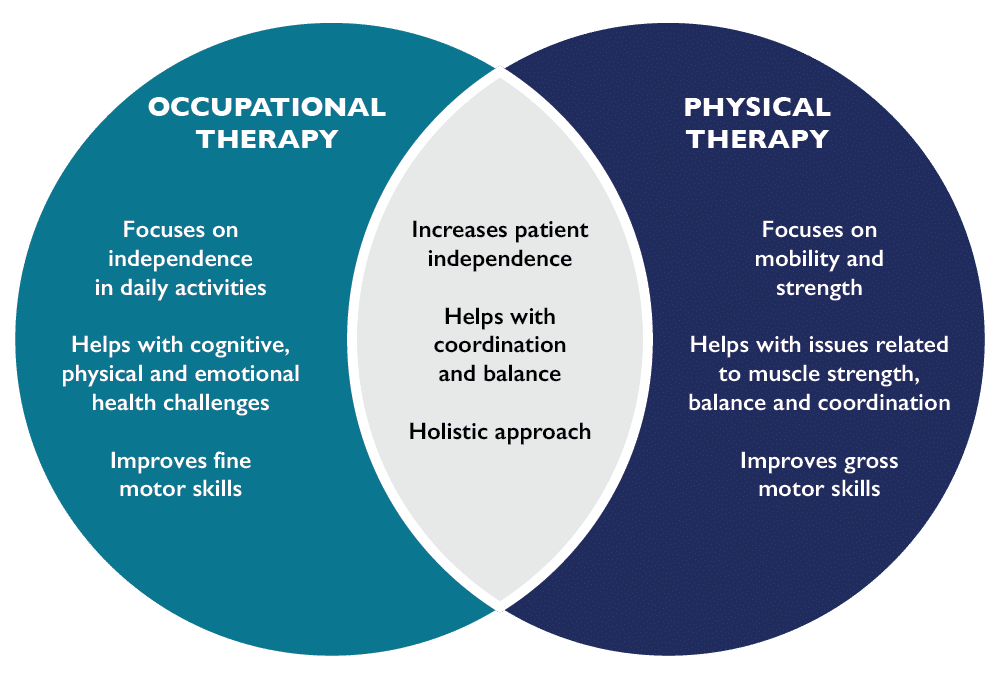Physical & Occupational Therapy: Getting You Moving Again
Physical therapy and occupational therapy are two distinct health care services that play crucial roles in helping individuals with physical limitations and challenges regain their independence and improve their overall well-being. While both therapies share similarities, they also have unique focuses and applications.

Physical Therapy (PT)
Physical therapists are movement experts who work to improve quality of life through prescribed exercise, hands-on care and patient education. They help patients manage chronic pain and disease, improve strength, recover from injuries and reduce the risk of injury in the future. Physical therapists also provide a safe and effective alternative treatment to medication, such as opioids, for the management of chronic pain conditions.
There are many barriers that can contribute to a lack of physical activity, including lack of time or energy, fear of injury or a chronic condition that limits movement. For some people, the barrier can be pain that makes movement a challenge. Visiting a physical therapist is one step to breaking down those barriers and becoming active.
Physical therapy utilizes several core principles to help patients achieve their movement goals. Once an initial evaluation of the patient is completed, a treatment plan will be tailored to that individual’s specific needs. Some treatment plans could include exercise, heat and cold therapy, balance training, manual therapy, aquatic therapy, dry needling and pelvic floor therapy.
Exercise and Rehabilitation
Physical therapy often involves targeted exercises and rehabilitation programs tailored to address specific impairments or injuries. These exercises aim to strengthen muscles, improve flexibility and promote overall physical fitness.
Manual Therapy
Hands-on techniques, such as joint mobilization and soft tissue mobilization, are common in physical therapy. These manual interventions help improve joint mobility, reduce pain and enhance tissue function.
Aquatic Therapy
Aquatic therapy is a specialized form of therapy that uses water resistance and buoyancy for rehabilitation. Performing pool-based exercise helps improve flexibility, balance and coordination, protect joints during exercise and reduce stress to injured tissues. Pool therapy is ideal for patients whose injuries require less than full weight-bearing activity due to arthritis, healing fractures or post-acute surgical repair.
Physicians often recommend or prescribe aquatic therapy specifically for:
- Low back pain
- Osteoarthritis
- Injuries requiring less than full weight bearing
- Joint pain from sports or repetitive activities
- Morbid obesity
- Orthopedic and running injuries, such as stress fractures
- Post-surgical rehabilitation
- Muscle weakness due to chronic or acute injury or illness.
According to Clint Hudson, PT, DPT, SCS, with Hattiesburg Clinic Physical Rehabilitation – Tatum Park, “Aquatics allows weight-bearing, walking and strengthening exercises sooner than on land, therefore speeding up the whole rehab process. It is safe for patients who don’t know how to swim or are afraid of the water.”
Dry Needling
Dry needling is a type of treatment performed by certified therapists to provide relief to patients experiencing acute or chronic pain associated with musculoskeletal pathologies. It is called dry needling because there is no medicine injected with the needle. The thin needles are usually inserted into and around painful myofascial trigger points to reduce tension and facilitate blood flow to target areas. Dry needling can be used to treat certain conditions, such as neck pain, low back pain, tendinitis, myofascial pain, TMJ, tension headaches/migraines and muscle strains.
Nancy Lewis, PT, DPT, Hattiesburg Clinic Physical Rehabilitation – Tatum Park, is certified in dry needling “Dry needling is an effective treatment that is used for certain conditions to reduce acute or chronic pain for a wide range of pathologies,” Lewis said. “It is often used in conjunction with strengthening, stretching and stability exercises to improve movement patterns and overall function.”
Pelvic Floor Therapy
Pelvic floor therapy is a form of physical therapy that focuses specifically on the pelvic region. The pelvic floor refers to the group of muscles, tendons and ligaments that support your pelvic organs, such as the bladder, uterus and rectum. Overtime, things like childbirth, chronic coughing, constipation and aging may cause dysfunction in the pelvic floor. Pelvic dysfunction can contribute to low back pain, hip pain and sacroiliac (SI) joint pain.
Pelvic floor therapy focuses on improving, correcting and strengthening the pelvic floor muscles. It can be used to treat pelvic pain, incontinence, pre- and postnatal conditions, pelvic organ prolapse and sexual dysfunction.
Lauren M. Reynolds, PT, DPT, with Hattiesburg Clinic Petal Physical Therapy, is the only physical therapist within Hattiesburg Clinic to hold qualifications that allow her to evaluate and treat conditions with pelvic floor therapy. Her focus is on treating women ages 16 and up. “I take a whole-body approach to care,” Reynolds said. “I provide my patients with a customized treatment plan geared towards improving quality of life, decreasing pain and improving function.”
Occupational Therapy (OT)
Occupational therapy differs from physical therapy in that it is focused on helping individuals achieve independence in their daily activities or occupations. Occupational therapists (OTs) work with people of all ages to address physical, cognitive and emotional challenges that may hinder their ability to engage in meaningful activities.
Occupational therapy is for patients who need assistance in improving tasks they need to do at home, school, work or other everyday activities. The assistance an individual receives might even include how to use certain devices to help them become more independent. These activities might include eating independently, participating and enjoying leisure activities, working at the office, bathing, combing hair, getting dressed or doing household activities such as laundry or cleaning.
Occupational therapy treatment plans vary based on individual needs, but some techniques could include heat, ice, ultrasound, blood flow restriction, hand therapy, strengthening and coordination exercises, joint mobilization and range of motion exercises. All of these modalities aim to ease pain and improve function.
Blood Flow Restriction Therapy
For patients who are recovering from an injury or surgery, blood flow restriction (BFRT) therapy helps encourage the healing process. It can be used to treat most upper and lower-body injuries, along with strengthening a variety of muscles to help patients return to daily activities. Blood flow restriction is often part of a larger physical or occupational therapy plan, combined with other forms of therapy.
The concept of BFRT is to partially restrict blood flow from the injured limb using a tourniquet, similar to a blood pressure cuff, during light weightlifting. Exercising the limb in the low oxygen state allows the person to use light resistance, yet achieve strength gains similar to exercising with heavier loads or high intensity.
“There is no questioning the benefits of muscle hypertrophy and strength gains that you can receive from BFRT,” Nathan Reynolds, PT, DPT, said. “The FDA-approved blood flow restriction unit is personalized to each patient’s limb occlusion pressure, which provides the safest environment to work under restricted blood flow and receive maximal benefits.”
Hand Therapy
Hand therapy is a specialized part of therapy that focuses on conditions of the hand and upper extremities. Hand therapy is a component of both physical and occupational therapy. Hattiesburg Clinic is pleased to have a certified hand therapist as part of our therapy team. John M. Porter, OT, CHT, with Hattiesburg Clinic Occupational Therapy, has years of specialized expertise in providing hand therapy to patients.
“Hands are necessary for almost every facet of life, and we take them for granted on a daily basis,” Porter said. “Hand rehabilitation is not easy on the patient or the therapist as hand and upper extremity rehabilitation can be a very intricate and sometimes complicated process. My goal is to help patients through this difficult time so they can get back to everyday life and fully engage in the things they want and need to live their best life.”
Hand therapy can be beneficial for patients suffering from carpal tunnel, arthritis, tendonitis, tennis elbow, fractures, injuries or nerve disorders.
Physical and Occupational Therapy at Hattiesburg Clinic
At Hattiesburg Clinic, our highly skilled, compassionate team of therapists are 100% focused on achieving optimal health and wellness for patients across south Mississippi so you can get back to living the life you enjoy. Our licensed therapists are specifically trained to evaluate, diagnose and manage health conditions and movement problems in people of all ages and abilities. We believe each patient is unique and our providers design individualized treatment plans to help every patient entrusted to our care reach their highest milestones.
The physical therapy team at Hattiesburg Clinic often takes a coordinated approach to patient care to ensure treatment success.
Jason Helton, PT, DPT, manager at Physical Rehabilitation – Tatum Park, said “We are strategically set up to provide seamless care to our Hattiesburg Clinic patient population in a variety of ways, most notably through direct communication with other Hattiesburg Clinic providers, which helps the patient before, during and after their physical therapy experience,” Helton said. “Being able to work hand-in-hand with a patient’s established health care team is key to recovery.”
To learn more about our physical therapy services or to contact one of our convenient locations, visit us online at www.hattiesburgclinic.com/physical-therapy/.
To learn more about Hattiesburg Clinic Occupational Therapy, call (601) 268-5757 or visit us online at www.hattiesburgclinic.com/occupational-therapy/.
